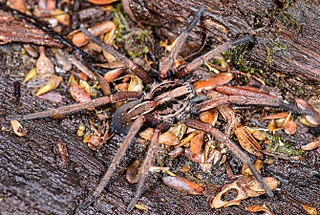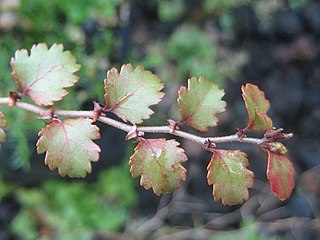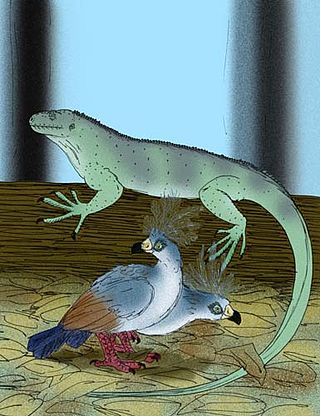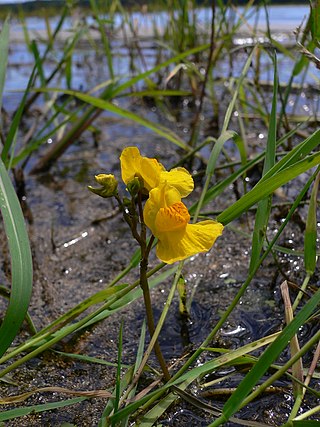
Hover flies, also called flower flies or syrphid flies, make up the insect family Syrphidae. As their common name suggests, they are often seen hovering or nectaring at flowers; the adults of many species feed mainly on nectar and pollen, while the larvae (maggots) eat a wide range of foods. In some species, the larvae are saprotrophs, eating decaying plant and animal matter in the soil or in ponds and streams. In other species, the larvae are insectivores and prey on aphids, thrips, and other plant-sucking insects.

Miturgidae is a family of araneomorph spiders that includes nearly 170 species in 29 genera worldwide. First described by Eugène Simon in 1886, it has been substantially revised, and includes the previous family Zoridae as a synonym, and excludes the family Xenoctenidae. Several genera have also been removed, such as the large genus Cheiracanthium, which was transferred to the Cheiracanthiidae.

Antarctic flora are a distinct community of vascular plants which evolved millions of years ago on the supercontinent of Gondwana. Presently, species of Antarctica flora reside on several now separated areas of the Southern Hemisphere, including southern South America, southernmost Africa, New Zealand, Australia, and New Caledonia. Joseph Dalton Hooker was the first to notice similarities in the flora and speculated that Antarctica had served as either a source or a transitional point, and that land masses now separated might formerly have been adjacent.

The New Zealand mud snail is a species of very small freshwater snail with a gill and an operculum. This aquatic gastropod mollusk is in the family Tateidae.

Anchor Island is an island in Dusky Sound in Fiordland.

Cyatholipidae is a family of spiders first described by Eugène Simon in 1894. Most live in moist montane forest, though several species, including Scharffia rossi, live in dry savannah regions. They occur in Africa, including Madagascar, New Zealand and Australia, and one species in Jamaica. Most members of this family hang beneath sheet webs. Fossil species occur in the Eocene aged Bitterfield and Baltic Ambers, suggesting a wider geographic distribution in the past.
The New Zealand catshark is a catshark of the family Scyliorhinidae in the order Carcharhiniformes. This species is endemic to in the deep waters around New Zealand. Its length is up to 45 centimetres (18 in). The New Zealand catshark is a small, little-known deep water bottom shark. It is dark brown around the top with a few widely spaced pale spots, and white below. It feeds on bottom-living crustaceans. It is also completely harmless to humans.

McMillan's catshark is a catshark of the family Scyliorhinidae, in the order Carcharhiniformes. McMillan's catshark is a small, rare, and little-known deepwater shark that is endemic to New Zealand. It is found at depths of 985–1350m on the lower continental slope around New Zealand, on the West Norfolk Ridge, and off North Cape. It can grow to a length of 45 cm.
Zootaxa is a peer-reviewed scientific mega journal for animal taxonomists. It is published by Magnolia Press. The journal was established by Zhi-Qiang Zhang in 2001 and new issues are published multiple times a week. From 2001 to 2020, more than 60,000 new species have been described in the journal accounting for around 25% of all new taxa indexed in The Zoological Record in the last few years. Print and online versions are available.

The Viti Levu giant pigeon or Fiji giant ground pigeon is an extinct flightless pigeon of Viti Levu, the largest island in Fiji. It was only slightly smaller than the dodo and Rodrigues solitaire and is the first giant flightless pigeon to be discovered on a Pacific island.

Rhytididae is a taxonomic family of medium-sized predatory air-breathing land snails, carnivorous terrestrial pulmonate gastropod molluscs in the superfamily Rhytidoidea.

Utricularia australis is a medium-sized, perennial species of aquatic bladderwort. This species has a vast geographic range, being found throughout Europe, in tropical and temperate Asia including China and Japan in the east, Central and Southern Africa, Australia and the North Island of New Zealand. The specific epithet "australis" is Latin for "southern" and reflects the fact that the discovery of this species was made in Australia in 1810.

Utricularia geminiscapa, the hiddenfruit bladderwort, is a perennial, medium-sized species of aquatic bladderwort. This species occurs naturally in the northeastern United States and Canada with one record from British Columbia in Western Canada. A small population is present near Westport in New Zealand where the species is thought to have recently naturalized- it was first recorded in this area in 1975.

The New Caledonian parakeet or New Caledonian red-crowned parakeet, is a species of parrot in the family Psittaculidae. It is endemic to New Caledonia. The species was once considered to be conspecific with the red-fronted parakeet of New Zealand but is now considered a full species and is known to be the basal species in the genus Cyanoramphus, which had its origins in New Caledonia.

Hipponix, common name hoof snails or hoof shells, is a genus of small sea snails with limpet-like shells, marine gastropod molluscs in the family Hipponicidae, the hoof snails. Many of the species in this genus have white shells.

The Ulodidae are a family of beetles belonging to Tenebrionoidea. They are native to the Southern Hemisphere, with species found in Australia, New Zealand, New Caledonia and Chile. Larvae and adults are generally found on dead wood or fungus associated with rotting wood, and are mycophagous. There are approximately 40 species in 16 genera.
Talpanas lippa, the Kauaʻi mole duck, is an extinct species of duck. It was first described by Andrew N. Iwaniuk, Storrs L. Olson, and Helen F. James in the journal Zootaxa in November 2009. It is the only known member of the genus Talpanas. It was endemic to the Hawaiian island of Kauai where the fossil remains were unearthed in the Makauwahi Cave, Maha‘ulepu. The archaeological association of the bones is about 6000 years BP.
Imber's petrel is an extinct seabird of gadfly petrel from the Chatham Islands. The species' epithet commemorates New Zealand ornithologist Mike Imber (1940–2011).

Megadictynidae is a family of araneomorph spiders first described by Pekka T. Lehtinen in 1967. They are endemic to New Zealand.

Dunollie is a small town on the West Coast of the South Island of New Zealand, approximately 8 km from Greymouth. It is at an elevation of approximately 30 meters.















